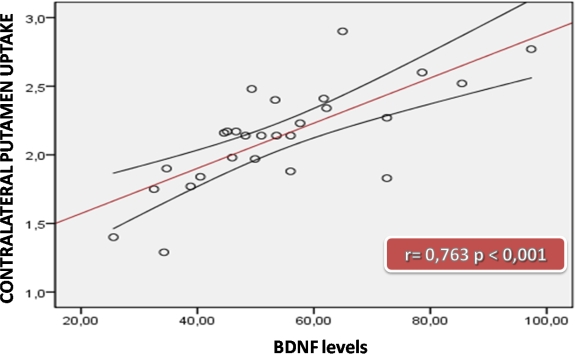Session Information
Date: Wednesday, June 22, 2016
Session Title: Parkinson's disease: Neuroimaging and neurophysiology
Session Time: 12:00pm-1:30pm
Location: Exhibit Hall located in Hall B, Level 2
Objective: To evaluate serum Brain-Derived NeurotrophicFactor(BDNF) levels in “de novo” untreated Parkinson’s disease (PD) patients and their relationship to nigrostriatal degeneration measured with [123I]FP-CIT SPECT.
Background: Different factors had been related to develope PD. Among them, some neurotrophic factors like BDNF are involved. It’s thought that low levels of them might play a major role in neural survival and neurodegeneration. Moreover levels of dopamine presynaptic transporter measured with [123I]FP-CIT SPECT had showed a good correlation to severity and progression of PD. Accordingly we hypothesized that lower BDNF will be find in patients with more striatal neurodegeneration.
Methods: Observational and cross-sectional study. “De novo” untreated PDpatients were consecutively recruited. Disease stage was evaluated by the Hoehn-Yahr (H&Y) scale. Disease severity and motor symptoms were rated according to the Unified Parkinson’s disease Rating Scale (UPDRSS) part III. All patients also underwent a psychiatric evaluation including a Structured Clinical Interview for DSM-IV Axis I disorders in order to exclude concomitant psychiatric disorders. Blood samples were collected at the same range of time. BDNF levels were analyzed by ELISA, twice. Furthermore a[123I]FP-CIT SPECT was performed in the PD group using a volumetric quantification of Regions Of Interest(ROI). To determine differences in BDNF levels between PD subjects and healthy controls a Mann-Whitney U test along with linear regression analysis accounting the effect for age and gender was performed. Additionally, the relationship between BDNF levels and the different ratios was assessed by a linear regression model accounting for age, PD duration and severity of motor symptoms. A p value < 0.05 was considered statistically significant.
Results: We recruited 27 PD patients [age 62.85±9.64 yo; 14 (51.85% male)]. Mean UPDRS-III score of 16 (range 12-22). The PDpatients showed significantly lower BDNF levels than healthy controls (54.04±16.68 ng/mL vs 74.25±31.12 ng/mL; p=0.005). Linear regression analysis showed a significant correlation between BDNF levels and average of striatal dopamine transporter binding, especially in contralateral and ipsilateral putamen
| B | IC 95% | R² | p value | |
| Contralateral Putamen | 0,015 | (0,008 – 0,022) | 0,592 | <0,001 |
| Ipsilateral Putamen | 0,015 | (0,009 – 0,021) | 0,586 | <0,001 |
| Contralateral Caudate | 0,016 | (0,007 – 0,026) | 0,433 | 0,004 |
| Ipsilateral Caudate | 0,017 | (0,008 – 0,026) | 0,414 | 0,006 |

Conclusions: Low serum BDNF levels are related to the degree of neurodegeneration in the nigrostriatal system.
LXVI Annual Meeting of Spanish Neurology Society.
To cite this abstract in AMA style:
G. Marti, N. Saez, M. Corominas, G. Cuberas, C. Lorenzo, O. De Fabregues, J. Alvarez-Sabin, M. Casas, J. Hernandez. Nigrostriatal degeneration and serum BDNF levels in patients with “de novo” untreated Parkinson’s disease [abstract]. Mov Disord. 2016; 31 (suppl 2). https://www.mdsabstracts.org/abstract/nigrostriatal-degeneration-and-serum-bdnf-levels-in-patients-with-de-novo-untreated-parkinsons-disease/. Accessed December 4, 2025.« Back to 2016 International Congress
MDS Abstracts - https://www.mdsabstracts.org/abstract/nigrostriatal-degeneration-and-serum-bdnf-levels-in-patients-with-de-novo-untreated-parkinsons-disease/
